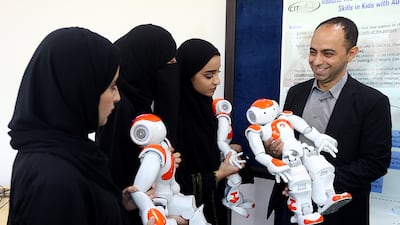AL AIN // A humanoid robot that can show emotions is being developed in the UAE.
Academics at the UAE University hope the robot will be able to care for special needs children, especially those with autism.
The project, which brings together experts from science and social science fields, aims to build human senses into robots.
Dr Fady Al Najjar, an expert in neuroscience and robotics, believed the robot could be of great assistance in autism therapy.
“Although autism is a worldwide problem, we in the UAE are one of the populations who suffer most,” he said.
He cited statistics from 2013 that stated one child in 50 born in this country has autism.
Because robots do not show emotions, they are perfect to deal with the complex behaviour of autistic children, Dr Al Najjar said.
“From our experience, we found that autistic children are more comfortable looking at and dealing with a robot than a human therapist,” he said.
“Moreover, we can control the emotional level of the robot based on the patient’s requirements, which is very hard to control in a therapist, who needs to deal with multiple patients at once.”
The project aims to build a “bio-inspired” robot, based on designs from nature, that can “provide an effective therapy and social communication to children with autism”.
“Our humanoid-robot will first aim to win the attention of the child, since the attention is the key factor to stimulate the child’s mirror neurons, the source of social development in human beings.
“Secondly, we will target the motor coordination training of the autistic children through the robot.”
Key factors will be the robot’s communication skills, body movement and ability to evaluate.
“We believe that our project has great potential not only to enhance the lives of those who struggle with autism, but also to solve an important issue in the ecumenical aspects of autism treatment in UAE,” Dr Al Najjar said.
Sociologist Dr Massimiliano Cappuccio, said there were ethical issues to iron out, such as to whom the robot would ultimately be responsible – its owner or the manufacturer.
“Is it possible to infuse morality into robots?” Dr Cappuccio asked. “Can you give them an ethical code of conduct, and if so, what is that?”
He said this development would be “the next industrial revolution, comparable to the introduction of cars”.
Dr Jose Berengueres, a professor of design thinking and robotics, is working on the machine’s appearance, creating artificial skin and muscles that replicate those of a human being.
He believed a robot could not be social if it was not designed with a human sense of touch in mind.
“Most robots today are visually orientated and made of hard materials, such as cold, hard steel and ABS plastic,” Dr Berengueres said.
“But our environments, homes and existing tools around us such as forks and knives were in fact designed for our hands.
“The result is that most robots built today cannot even grab an Ikea knife, for instance. So compliance and sense of touch can go a long way.
“We humans are very much touch orientated, even if unconsciously.”
He said newborn babies, even if fed well, were more at risk of death if not touched by humans.
“As robots will interact more and more with humans, the question is, do you want a hard robot taking care of your baby or would you prefer a soft one?”
mswan@thenational.ae

